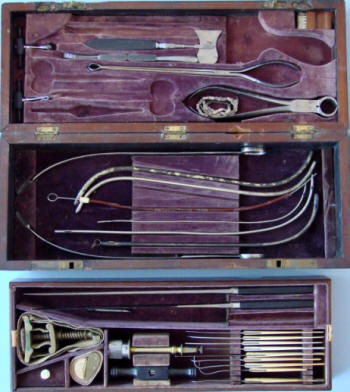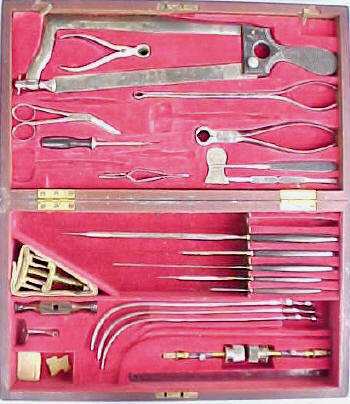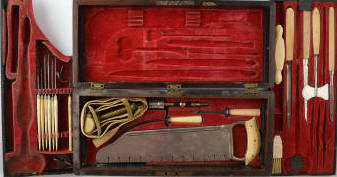Presentation and Tribute Surgical Sets
Page 8
Pre- & Post- Civil War:
Display 1
|
Display 2 |
Display 3
Civil War:
Display 4 |
Display 5 |
Display 6
| Display 7
Presentation Sets
'SEARCH
THIS SITE'
Indexed list of all Civil War surgical sets in this
collection
Presentation and Tribute Surgical Sets
During and immediately after the Civil War,
many surgeons were presented with civilian surgical sets as gifts-in-tribute or
to say thank-you from their grateful patients and fellow soldiers whom that doctor/surgeon served during the
War. These ‘Presentation or Tribute’ sets are almost all civilian surgery set
versions with engraved brass name plates done by the set maker or by an engraver
hired by the presenting militia members. These sets are hand-engraved.
The name or regiment is not scratched on with the point of a knife. The quality varies, but not the
intention.
The physical characteristics and instrument
forms or maker name-strikes in the surgical sets generally date the time of the
gift and as collectors, we, as collectors, know these dates in detail. Used military-issued
sets by the U. S. Army Hospital or Medical Departments would not have been available or
used for presentation until possibly after the war, so you don’t see those kinds
of sets as ‘Presentation’ sets. Surgeons didn't 'own'
their government issued sets and had to turn them in to the quartermasters at
the end of their deployment. There are unused military surgical sets that
existed after the war and a surgeon or individual may have purchased one of those sets at a
government auction immediately after the War, but for the most part we would not
expect to see government owned and marked military sets used as gifts which were engraved as presentation
sets.
As for the ‘provenance’ of any surgical set,
let us be clear that unless you have iron-clad proof of ownership and use, we do
not purport or accept that any ‘presentation or attributed’ surgical set was
used during the Civil War. Romanticized stories about your ‘great…granddaddy,
who was a surgeon makes for a great story, but without proof, it’s just that…a
story.
There are basically two groups of surgical
set provenances: civilian sets and government issued military sets. U. S. Army
military sets have iron-clad ownership and use: they were owned by the
government of the U.S. Army or State Volunteer Militias and used during the War
by military surgeons, not contract doctors.
As far as CSA sets are concerned,
there are no government military issued sets. NONE! Every set attributed to
the Confederate States Army use is questionable, no matter how much blood is on the tourniquet or how
glorious the romanticized story of its existence and ownership. It is possible
to ‘prove’ a given doctor owned a set since his name may be engraved on the
civilian version of a set or there is a chain of custody (family ownership). If you
have a civilian set that has an attribution to a given surgeon or doctor on
either side, we are willing to accept proven chain-of-possession or family
history and any period relative documentation, but otherwise, there is no way we
are going to claim or accept that a set was used during the War or owned by a
specific surgeon at such and such battle.
If a surgeon or his regiment has a wonderful history before,
during, or after the War, we love to hear or use that history, but proving
chain-of-ownership is essential and that proof must be signed or in someway
provable, otherwise, it's just he said/she said, not proof positive. History of the given military surgeon or
contract doctor during the War is wonderful, but will have no bearing on the
value of a set unless you can offer iron-clad proof of its ownership, date of
manufacture before or during the War, and
possession by the owner. Many of the presentation sets were made after the
war and again, these sets were owned by the doctor, but never saw action during
the war because they didn't exist during the war.
In light of the above CYA statement(s), what
follow are sets we believe merit discussion and possession for this collection.
Enjoy them for the medical history they represent relative to the brave men who
used them and served during the Civil War.
|
8.1
1861 Civil War U. S. A. Hosp. Dept.
partial surgical set by Hernstein, which is marked as belonging to Dr. Frank Ridgway, of the 73 Infantry Regiment, New York Volunteers, more commonly
known as the Second Fire Zouaves. Bilateral military sliding
latches.
See additional
details and
EXPANDED photos |
 |
8.2
c. 1860, Hernstein, New York, large
surgical set owned by a Confederate doctor and the type of set a
contract or Confederate surgeon would have owned and used. Keyed
lock.
See additional
details and
EXPANDED
photos |
 |
|
8.3
c. 1860, Geo. Tiemann, N.Y., partial surgery
set presented to John Ordway, M.D.
See additional
details and
EXPANDED
photos
|
 |
Civil War:
Display 4 |
Display 5 |
Display 6
| Display 7
Presentation Sets
'SEARCH
THIS SITE'
Indexed list of all Civil War surgical sets in this
collection
|